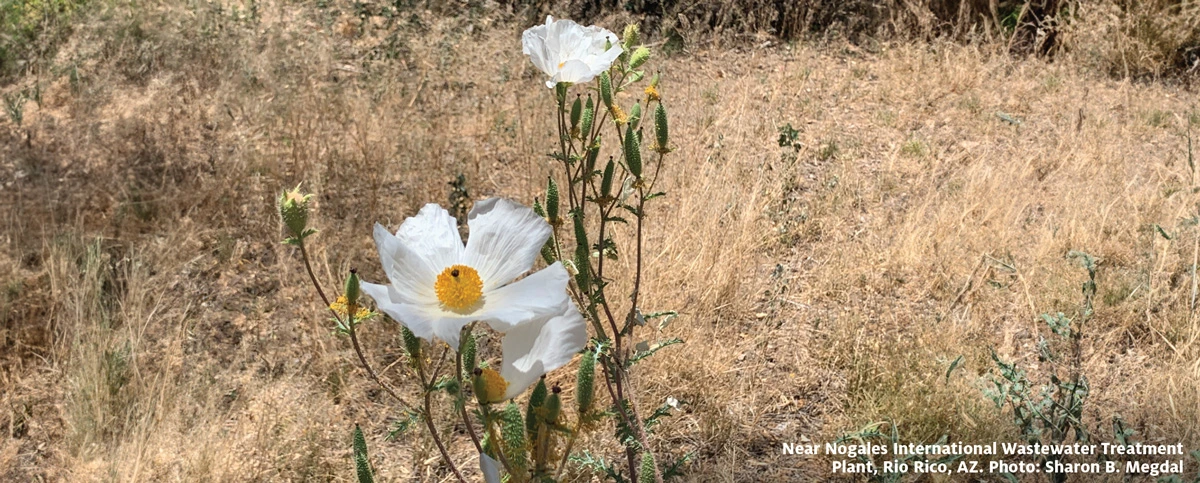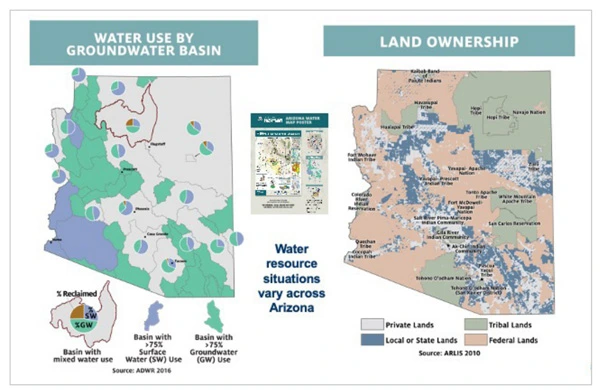
Reflections: On a Busy Spring (pdf)
It is July, more than three months since my last Reflections, which was written from the UN Water Conference on World Water Day. The reason for the gap: an overabundance of work-related activities. Teaching, project work, engagement and speaking activities, media interviews, and more have kept me very busy.
Informing audiences of many kinds about our water situation has always been meaningful for me. Interest in understanding the complicated and uncertain implications to Arizona of low Colorado River flows has never been higher. Groundwater issues are of heightened interest as well. Whether the audience consists of students in my graduate course “Water Policy in Arizona and Semi-arid Regions,” community groups, conference/workshop attendees (including international), and/or the media, it’s always necessary to provide sufficient context and nuance. Though I have been complimented for explaining complex water issues concisely, I find it increasingly difficult to deliver quick summaries and explanations. Uneven impacts across geographic regions, across jurisdictions, and across and among water using sectors make generalizations impossible. Two examples drive this home.

Selected maps from the WRRC Arizona Water Map Poster
The first relates to the impacts of Colorado River cutbacks. Statements like “Arizona’s priority is junior to that of California” and “deliveries of Colorado River water to Arizona agriculture have been cut” must be corrected. While it is true that Central Arizona Project (CAP) water is junior to California’s Colorado River water deliveries, not all Colorado River water used by Arizona entities and jurisdictions, including Native Nations, is junior to California’s. Moreover, within the Central Arizona Project’s three-county service area (Maricopa, Pinal, and Pima Counties), different water-using groups have been assigned different priorities, with agricultural CAP water deliveries generally assigned low priority. Outside of the CAP service area, agriculture may have high priority water rights. Many audiences, including news media from across the world, need assistance in understanding these complexities. More than ever, I am spending considerable time providing background. Showing maps can help, so I often use maps of water use and land ownership from the WRRC’s Water Map Poster to drive home the point that situations vary considerably across Arizona.
The second example relates to the early June release by the Arizona Department of Water Resources (ADWR) of its new groundwater model for the Phoenix Active Management Area (AMA). ADWR’s online Phoenix AMA Groundwater Supply Updates page states: “In keeping with these findings of unmet demand [for groundwater], the State will not approve new determinations of Assured Water Supply within the Phoenix AMA based on groundwater supplies. Developments within existing Certificates or Designations of Assured Water Supply may continue, but communities or developers seeking new Assured Water Supply determinations will need to do so based on alternative water sources.” Unpacking this statement requires a great deal of background knowledge. In addition, it is critical to recognize that ADWR’s pronouncement, with its unprecedented and serious implications, has uneven application across the many cities and towns in the Phoenix AMA, depending on the local water source(s) and Assured Water Supply status. When media representatives indicate that they only need 10 minutes of my time for an interview on this type of complex topic, I suggest more time will be needed — because it is.
These are just two examples of the complicated water matters that more people of more varied backgrounds want to understand. Further, our constantly changing circumstances make my educational and engagement activities ever more challenging!
My research projects likewise connect to surface water and groundwater challenges. I am working on the Arizona portion of a multi-state USDA-funded project that considers the long-term situation of irrigated agriculture in the Southwest. The Arizona team’s focus is on the Pinal Active Management Area, where water use remains predominantly agricultural. Farmers there have experienced large cutbacks in surface water supply. Even before the Phoenix AMA model report was released, ADWR’s Pinal AMA groundwater model revealed a significant deficit of groundwater availability in that AMA when compared with projected groundwater use. The agricultural sector’s responses to surface water supply cutbacks—substitution of groundwater and land fallowing—have negative implications for the groundwater deficit and agricultural sustainability. Complexities abound. With decisions to be made over the short, intermediate, and long terms, identifying potential future scenarios is challenging.
Up to now, our work on characterizing the groundwater situation for selected aquifers along the Arizona-Sonora border through the Transboundary Aquifer Assessment Program has focused mostly on the hydrogeologic system’s physical aspects. Looking forward, we intend to characterize socioeconomic aspects of water use as well. Especially difficult to predict in a transboundary setting, the impacts of changing groundwater conditions due to changing climate on communities largely or fully dependent on groundwater require elucidation.
I often say that everything I do professionally is interrelated, and this is certainly true when it comes to my current board, commission, and council memberships. I serve as one of two University of Arizona representatives to the six-person Board of Governors for the Kasser Joint Institute for Food, Water, and Energy Security. University of Arizona researchers have been working with researchers based in Israel’s Arava Valley to advance the application of aquaponics and agrivoltaics in regions facing food, water, and/or energy insecurity. Over the past six months, I have served as one of 10 members of University of Arizona President Robbins’ Advisory Commission on the Future of Agriculture and Food Production in a Drying Climate. The Commission’s report, which is nearing completion after six months of work, identifies threats and potential solutions to maintaining and increasing food production in Arizona and other arid regions. Looking forward, it highlights opportunities to expand existing efforts and develop new programs and partnerships to address the serious global challenge of producing more food with less water. Finally, I have the honor of serving on Governor Hobbs’ Water Policy Council, which was established by Executive Order. The charge to the Governor’s Water Policy Council (GWPC) is “to analyze and recommend updates, revisions and additions to the GMA [1980 Groundwater Management Act] and related water legislation, which shall include, without limitation, analysis and recommendations for groundwater management outside current Active Management Areas.” To meet Governor Hobbs' end-of-year deadline for recommendations, GWPC members divided into two committees. The first is focusing on the Assured Water Supply Program. The second committee, on which I serve, is focusing on rural groundwater, which is largely unregulated. For the work of these committees, time is of the essence.
As I reflect on how quickly the first half of 2023 has gone by and the increasing intensity of the efforts of so many to work on solutions to our unprecedented water challenges, I suspect that the rest of 2023 will go by in a flash. Though the amount of work is daunting, I look forward to it!

